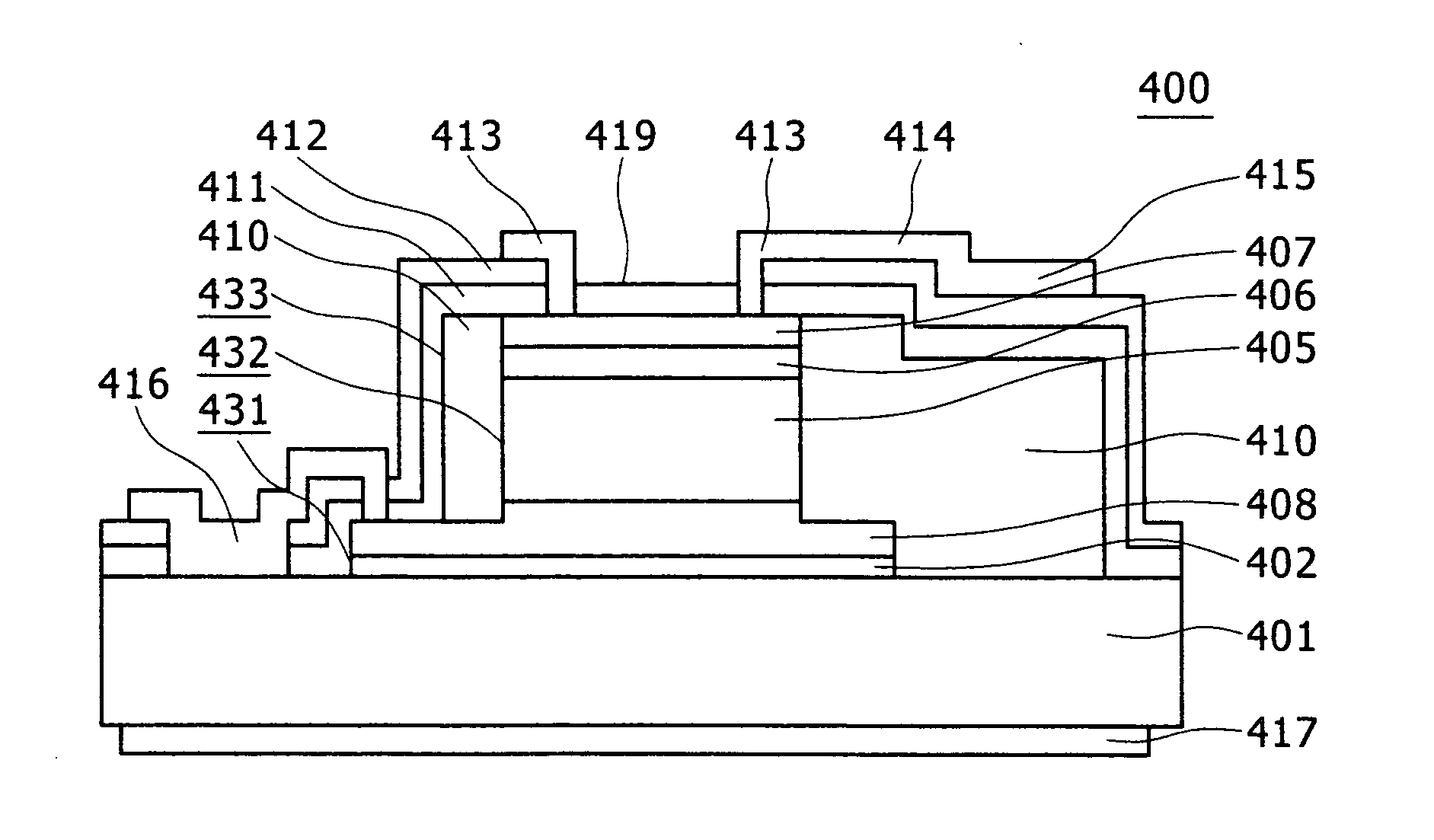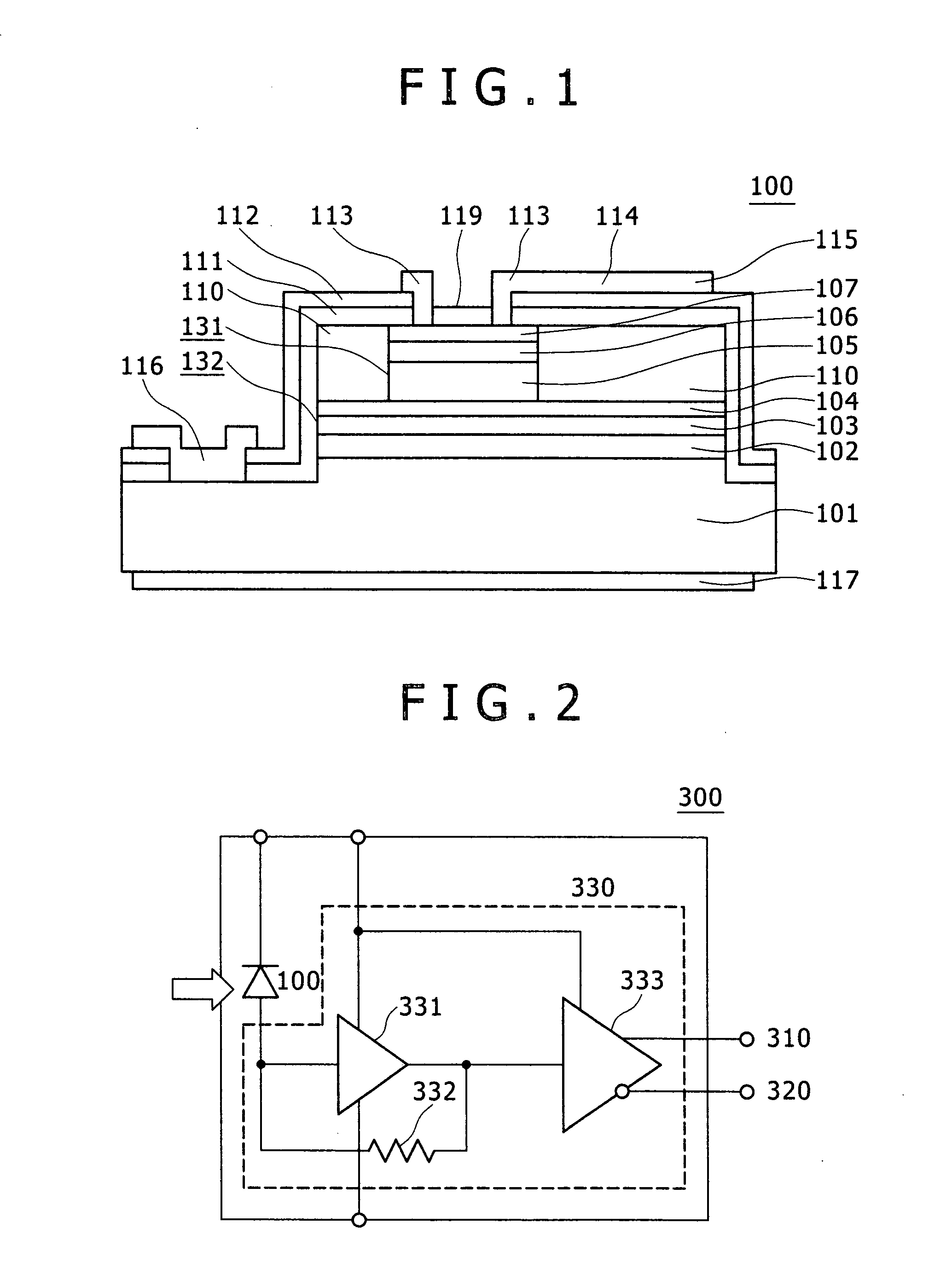Optical device and optical module
a technology of optical modules and optical devices, applied in semiconductor devices, lasers, semiconductor lasers, etc., can solve the problems of insufficient capacitance reduction, restricted wiring direction, and insufficient disconnection of wiring, so as to reduce parasitic capacitance, reduce capacitance, and high resistance re-growth
- Summary
- Abstract
- Description
- Claims
- Application Information
AI Technical Summary
Benefits of technology
Problems solved by technology
Method used
Image
Examples
embodiment 1
[0023] Embodiment 1 will be described with reference to FIGS. 1 and 2. Here FIG. 1 is a cross-sectional view of a top-illuminated-type APD (Avalanche Photo Diode) device. FIG. 2 is a block diagram of an optical receiver module in which the APD device is mounted. In order to avoid complexity of illustration, hatching indicating cross sections is omitted in FIG. 1 and subsequent cross-sectional views.
[0024] In FIG. 1, an APD device 100 has a structure in which a lower buffer layer 102 (conductive type: n-type InAlAs layer, impurity concentration: 1E18 cmˆ−3 (1×1018 cm−3), thickness: 0.5 μm (micrometers)), a multiplication layer 103 (n-type InAlAs layer, 1E14 cmˆ−3, 0.4 μm), a field-control layer 104 (p-type InAlAs layer, 8E17 cmˆ−3, 0.04 μm), an absorption layer 105 (p-type InGaAs layer, 1E15 cmˆ−3, 1.8 μm), a cap layer 106 (upper buffer layer) (p-type InAlAs layer, 1E18 cmˆ−3, 0.7 μm), and a p-type contact layer 107 (p-type InGaAs layer, 5E18 cmˆ−3, 0.1 μm) are laminated over an InP...
embodiment 2
[0034] In Embodiment 1, the top-illuminated-type APD device has been described. In Embodiment 2, a bottom-illuminated-type APD device will be described with reference to FIG. 3. Here FIG. 3 is a cross-sectional view of a bottom-illuminated-type APD device. Incidentally, as the structure of Embodiment 2 is generally the same as that of Embodiment 1, substantially like parts are denoted by like reference numerals and the description will not be repeated.
[0035] In a bottom-illuminated-type APD device 100′ shown in FIG. 3, the anti-reflection coating 119 (SiN film), which is provided in the light receiving portion of the top-illuminated-type APD device in FIG. 1, is eliminated by etching and a p-type ohmic electrode 113′ is formed over the entire portion. As it is the bottom illuminated type, an anti-reflection coating 119′ is provided in place of the bottom metal film 117 for die bonding.
[0036] With the bottom-illuminated-type APD device according to the embodiment, the same effect a...
embodiment 3
[0037] Embodiment 3 will be described below with reference to FIGS. 4 and 5. Here FIG. 4 is a cross-sectional view of a top-illuminated-type pin-PD device. FIG. 5 is a block diagram of an optical receiver module in which the pin-PD device is mounted.
[0038] In FIG. 4, a pin-PD device 400 has a structure in which a buffer layer 402 (undoped InP layer, 0.2 μm), an n-type contact layer 408 (n-type InGaAsP layer, 8E18 cmˆ−3, 0.4 μm), an absorption layer 405 (n-type InGaAs layer, 5E14 cmˆ−3, 2.0 μm), a cap layer 406 (p-type InGaAsP layer, 1E18 cmˆ−3, 0.2 μm), and a p-type contact layer 407 (p-type InGaAs layer, 1E19 cmˆ−3, 0.1 μm) are laminated over an InP (semi-insulating) substrate 401. The main active region of the pin-PD structure in the PD device 400 is formed by a three-step mesa technology. An outermost first mesa 431 is a step between the n-type contact layer 408 and the InP substrate 401. The first mesa 431 is formed by a combination of a vertical portion etched from the p-type ...
PUM
 Login to View More
Login to View More Abstract
Description
Claims
Application Information
 Login to View More
Login to View More - R&D
- Intellectual Property
- Life Sciences
- Materials
- Tech Scout
- Unparalleled Data Quality
- Higher Quality Content
- 60% Fewer Hallucinations
Browse by: Latest US Patents, China's latest patents, Technical Efficacy Thesaurus, Application Domain, Technology Topic, Popular Technical Reports.
© 2025 PatSnap. All rights reserved.Legal|Privacy policy|Modern Slavery Act Transparency Statement|Sitemap|About US| Contact US: help@patsnap.com



